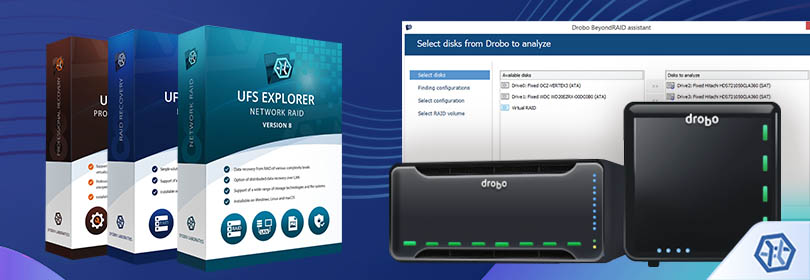
Drobo BeyondRAID assistant – a new tool to simplify your Drobo data recovery
19.05.2023
Data recovery from Drobo has long been a tricky task even for seasoned experts – all because of the highly dynamic nature of BeyondRAID, the proprietary technology employed in the units. Fortunately, with advanced software tools like UFS Explorer, data loss from Drobo no longer presents such a challenge. And certain updates to the software have brought yet more improvements to the Drobo-related functionality available in the Professional, RAID and Network RAID editions. They enable users to reconstruct Drobo volumes just with several clicks and even find the gone BeyondRAID configurations for further data recovery. The RAID and Network RAID editions support the technology implemented on maximum 5 drives, whereas more complex BeyondRAID setups can be handled with UFS Explorer Professional Recovery.
To begin with, the procedure of restoring BeyondRAID has been considerably simplified. All the parameters required to assemble the storage can be detected by the software automatically. There is no need to specify the size of the stripe or adjust the order of components – simply select Drobo drives from the list and build the array as "Drobo BeyondRAID". The only setting you may have to define is the LUN number, in case there is more than one LUN.

In the majority of instances, the intact Drobo volume will be mounted in the interface and can be opened right away to save the accessible files or recover the missing data. However, there are still cases when the configuration created by Drobo has been damaged and cannot be properly read out. Also, the assembled volume may appear to be of no use – for example, when the device was reset to the factory defaults. In that event, the Drobo drives get re-initialized, so a new logical volume created over them will contain none of the user files. Provided that the previous configuration still exists somewhere on the storage, such a problem can be addressed with a special instrument called Drobo BeyondRAID Assistant.
Launched from the “RAID” item of the main menu, the Drobo BeyondRAID Assistant is capable of searching for the lost BeyondRAID configurations. The opened window will contain all the connected storages together with the virtually assembled complex volumes. The software automatically picks out the disks with the Drobo "markup" for analysis, yet, you can easily choose other storage devices or remove any drive if you are sure it is not required.

Once the needed drives are chosen, the program quickly scans them for older fragments or copies of metadata tables that will allow translating data chunks from the storage and reconstruct the missing virtual file systems. The quality of the reconstruction will depend on the age and condition of the found metadata.

After the scanning is completed, the software will display all the found BeyondRAID configurations along with the information about them, like ID, size of the allocated data, type of redundancy and the component disks. The newest configuration will appear at the bottom of the list and the older ones will be displayed above it. The obtained results are cached so that you could promptly get back to them in case of an incorrect choice.

Select the necessary configuration and the program will show the Drobo volume it holds. Click "Open" and it will be instantly mounted in the software interface.

The mounted complex storage can be easily opened or processed in the software like any conventional storage device.

Another potential complication when dealing with Drobo may arise if the unit makes use of Drobo Accelerator Cache. In case of an incorrect shutdown of the system, hardware malfunction or unexpected removal of the mSATA SSD, a part of the data may be left solely on this module that doesn’t belong to the primary BeyondRAID configuration. Such an obstacle can be likewise handled with the help of UFS Explorer.
The Professional edition of the program lets you apply the information available in the cache to the reconstructed BeyondRAID set, as demonstrated in Data recovery from Drobo with active mSATA cache, thus enabling correct reading of the storage content. The cached data may also come in handy when certain files got damaged due to the presence of defective blocks on the original member drives or some other types of failures.

As you can see, the software greatly facilitates the work with Drobo and makes it possible to efficiently recover the missing data even after a "fresh start" for the device. If you are interested in trying out its features for yourself, simply download the latest version of the product for your operating system.
